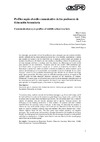Please use this identifier to cite or link to this item:
https://accedacris.ulpgc.es/jspui/handle/10553/74617
| Title: | Perfiles según el estilo comunicativo de los profesores de Educación Secundaria | Other Titles: | Communication style profiles of middle-school teachers | Authors: | Santana Monagas, Elisa Fitzpatrick, Isabel Núñez Alonso, Juan Luis León González-Vélez, Jaime José Loro Ferrer, Juan Francisco |
UNESCO Clasification: | 5801 Teoría y métodos educativos 5803 Preparación y empleo de profesores |
Keywords: | Educación para la comunicación Formación docente Motivación por aprender Educación Secundaria Educación en el aula, et al |
Issue Date: | 2019 | Conference: | XIX Congreso Internacional de Investigación Educativa (AIDIPE 2019) | Abstract: | Los mensajes que pueden utilizar los profesores para conseguir que sus alumnos estudien pueden centrarse en las consecuencias negativas (ej. si no estudias, suspenderás y tendrás que estudiar en verano) o en los beneficios (ej. si estudias, podrás elegir qué estudiar al terminar bachillerato). El objetivo de este estudio es identificar clústers de profesores que utilizan mensajes similares y analizar, entre los clústers, las diferencias en la motivación para aprender de sus estudiantes. Formaron parte de este estudio 1209 estudiantes que informaron sobre sus profesores (n=49) de 10 centros de Educación Secundaria. Para determinar el número de clústers se utilizó la técnica de análisis de perfiles latentes y para analizar las diferencias en la motivación para aprender se utilizó el método de tres pasos (unequal variances). Los resultados mostraron que una solución de tres clústers era la que mejor ajuste presentaba. El primer grupo no utilizaba mensajes positivos, ni negativos. El segundo grupo utilizaba mensajes positivos centrados en los beneficios de estudiar. Finalmente, el tercer grupo se caracterizó por la utilización de mensajes centrados tanto en las consecuencias positivas como negativas. Se observó una mayor motivación intrínseca para aprender en el segundo grupo, y una menor en el primer grupo. To promote study, teachers can rely on loss-frases messages (e.g. if you don’t study, you’ll fail and will have to study in the summer) or gain-framed (e.g. if you study, you’ll be able to choose what to study when you finish high school). The aim of this study was to identify clusters of teachers who use similar messages and to analyse, between clusters, the differences in the learning motivation of their students. 49 teachers and their students (n=1209) from 10 secondary schools took part in this study. To determine the number of clusters we used latent profile analysis and to analyse the differences in the motivation to learn we used the unequal variances three-step method. The results showed that a three-clusters solution better fit data. The first group used neither possitive nor negative messages. The second group used possitive messages focused on the benefits of studying. Finally, the third group was characterized by the use of messages focused on both positive and negative consequences. A higher motivation to learn was observed in the second group, and a lower one in the first group. |
URI: | https://accedacris.ulpgc.es/handle/10553/74617 | Source: | XIX Congreso Internacional de Investigación Educativa: Investigación comprometida para la transformación social (AIDIPE 2019) |
| Appears in Collections: | Actas de congresos |
Page view(s)
220
checked on Oct 31, 2024
Download(s)
44
checked on Oct 31, 2024
Google ScholarTM
Check
Share
Export metadata
Items in accedaCRIS are protected by copyright, with all rights reserved, unless otherwise indicated.
